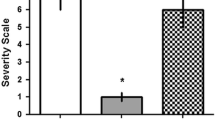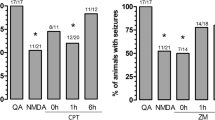Abstract
N-methyl D-aspartate (NMDA) preconditioning is evoked by the administration of a subtoxic dose of NMDA and is protective against neuronal excitotoxicity. This effect may involve a diversity of targets and cell signaling cascades associated to neuroprotection. Phosphatidylinositol-3 kinase/protein kinase B (PI3K/Akt) and mitogen-activated protein kinases (MAPKs) such as extracellular regulated protein kinase 1/2 (ERK1/2) and p38MAPK pathways play a major role in neuroprotective mechanisms. However, their involvement in NMDA preconditioning was not yet fully investigated. The present study aimed to evaluate the effect of NMDA preconditioning on PI3K/Akt, ERK1/2, and p38MAPK pathways in the hippocampus of mice and characterize the involvement of PI3K on NMDA preconditioning-evoked prevention of seizures and hippocampal cell damage induced by quinolinic acid (QA). Thus, mice received wortmannin (a PI3K inhibitor) and 15 min later a subconvulsant dose of NMDA (preconditioning) or saline. After 24 h of this treatment, an intracerebroventricular QA infusion was administered. Phosphorylation levels and total content of Akt, glycogen synthase protein kinase-3β (GSK-3β), ERK1/2, and p38MAPK were not altered after 24 h of NMDA preconditioning with or without wortmmanin pretreatment. Moreover, after QA administration, behavioral seizures, hippocampal neuronal degeneration, and Akt activation were evaluated. Inhibition of PI3K pathway was effective in abolishing the protective effect of NMDA preconditioning against QA-induced seizures, but did not modify neuronal protection promoted by preconditioning as evaluated by Fluoro-Jade B staining. The study confirms that PI3K participates in the mechanism of protection induced by NMDA preconditioning against QA-induced seizures. Conversely, NMDA preconditioning-evoked protection against neuronal degeneration is not altered by PI3K signaling pathway inhibition. These results point to differential mechanisms regarding protection against a behavioral and cellular manifestation of neural damage.






Similar content being viewed by others
Abbreviations
- Akt:
-
Protein kinase B
- ERK:
-
Extracellular signal–regulated kinases
- GSK-3β:
-
Glycogen synthase kinase-3 beta
- MAPK:
-
Mitogen-activated protein kinases
- NMDA:
-
N-methyl D-aspartate
- NQnc:
-
NMDA-QA non-convulsed group
- NQc:
-
NMDA-QA convulsed group
- OGD:
-
Oxygen/glucose deprivation
- PI3K:
-
Phosphatidylinositol-3 kinase
- p38MAPK :
-
P38 mitogen-activated protein kinases
- QA:
-
Quinolinic Acid
- Wort:
-
Wortmannin
References
Bhuiyan MI, Jung SY, Kim HJ, Lee YS, Jin C (2011) Major role of the PI3K/Akt pathway in ischemic tolerance induced by sublethal oxygen-glucose deprivation in cortical neurons in vitro. Arch Pharm Res 34:1023–1034. https://doi.org/10.1007/s12272-011-0620-3
Boeck CR, Ganzella M, Lottermann A, Vendite D (2004) NMDA preconditioning protects against seizures and hippocampal neurotoxicity induced by quinolinic acid in mice. Epilepsia 45:745–750. https://doi.org/10.1111/j.0013-9580.2004.65203.x
Boeck CR, Kroth EH, Bronzatto MJ, Vendite D (2005) Adenosine receptors co-operate with NMDA preconditioning to protect cerebellar granule cells against glutamate neurotoxicity. Neuropharmacology 49:17–24. https://doi.org/10.1016/j.neuropharm.2005.01.024
Calloni GW, Penno CA, Cordova FM, Trentin AG, Neto VM, Leal RB (2005) Congenital hypothyroidism alters the phosphorylation of ERK1/2 and p38MAPKin the hippocampus of neonatal rats. Dev Brain Res 154:141–145. https://doi.org/10.1016/j.devbrainres.2004.10.005
Chuang DM, Gao XM, Paul SM (1992) N-methyl-D-aspartate exposure blocks glutamate toxicity in cultured cerebellar granule cells. Mol Pharmacol 42:210–216
Constantino LC, Pamplona FA, Matheus FC, Ludka FK, Gomez-Soler M, Ciruela F, Boeck CR, Prediger RD, Tasca CI (2015) Adenosine A1receptor activation modulates N-methyl-d-aspartate (NMDA) preconditioning phenotype in the brain. Behav Brain Res 282:103–110. https://doi.org/10.1016/j.bbr.2014.12.056
Cruz SL, Gauthereau MY, Camacho-Muñoz C, López-Rubalcava C, Balster RL (2003) Effects of inhaled toluene and 1,1,1-trichloroethane on seizures and death produced by N-methyl-D-aspartic acid in mice. Behav Brain Res 140:195–202. https://doi.org/10.1016/S0166-4328(02)00323-6
de Araújo Herculano B, Vandresen-Filho S, Martins WC, Boeck CR, Tasca CI (2011) NMDA preconditioning protects against quinolinic acid-induced seizures via PKA, PI3K and MAPK/ERK signaling pathways. Behav Brain Res 219:92–97. https://doi.org/10.1016/j.bbr.2010.12.025
Dickie BGM, Holmes C, Greenfield SA (1996) Neurotoxic and neurotrophic effects of chronic N-methyl-D-aspartate exposure upon mesencephalic dopaminergic neurons in organotypic culture. Neuroscience 72:731–741. https://doi.org/10.1016/0306-4522(95)00611-7
Dirnagl U, Simon RP, Hallenbeck JM (2003) Ischemic tolerance and endogenous neuroprotection. Trends Neurosci 26:248–254
Gidday JM (2006) Cerebral preconditioning and ischaemic tolerance. Nat Rev Neurosci 7:437–448
Hanada M, Feng J, Hemmings BA (2004) Structure, regulation and function of PKB/AKT—a major therapeutic target. Biochim Biophys Acta Proteins Proteomics 1697:3–16. https://doi.org/10.1016/j.bbapap.2003.11.009
He SF, Jin SY, Wu H, Wang B, Wu YX, Zhang SJ, Irwin MG, Wong TM, Zhang Y (2015) Morphine preconditioning confers cardioprotection in doxorubicin-induced failing rat hearts via ERK/GSK-3β pathway independent of PI3K/Akt. Toxicol Appl Pharmacol 288:349–358. https://doi.org/10.1016/j.taap.2015.08.007
Irving EA, Bamford M (2002) Role of mitogen- and stress-activated kinases in ischemic injury. J Cereb Blood Flow Metab 22:631–647. https://doi.org/10.1097/00004647-200206000-00001
Jia J, Wang X, Li H, Han S, Zu P, Li J (2007) Activations of nPKCε and ERK1/2 were involved in oxygen-glucose deprivation-induced neuroprotection via NMDA receptors in hippocampal slices of mice. J Neurosurg Anesthesiol 19:18–24. https://doi.org/10.1097/01.ana.0000211020.88431.e2
Maddahi A, Edvinsson L (2010) Cerebral ischemia induces microvascular pro-inflammatory cytokine expression via the MEK/ERK pathway. J Neuroinflammation 7:14. https://doi.org/10.1186/1742-2094-7-14
Marganella C, Bruno V, Matrisciano F, Reale C, Nicoletti F, Melchiorri D (2005) Comparative effects of levobupivacaine and racemic bupivacaine on excitotoxic neuronal death in culture and N-methyl-D-aspartate-induced seizures in mice. Eur J Pharmacol 518:111–115. https://doi.org/10.1016/j.ejphar.2005.06.022
Miyawaki T, Mashiko T, Ofengeim D, Flannery RJ, Noh K-M, Fujisawa S, Bonanni L, Bennett MVL, Zukin RS, Jonas EA (2008) Ischemic preconditioning blocks BAD translocation, Bcl-xL cleavage, and large channel activity in mitochondria of postischemic hippocampal neurons. Proc Natl Acad Sci 105:4892–4897. https://doi.org/10.1073/pnas.0800628105
Noshita N, Lewén A, Sugawara T, Chan PH (2002) Akt phosphorylation and neuronal survival after traumatic brain injury in mice. Neurobiol Dis 9:294–304. https://doi.org/10.1006/nbdi.2002.0482
Ogita K, Okuda H, Yamamoto Y, Nishiyama N, Yoneda Y (2003) In vivo neuroprotective role of NMDA receptors against kainate-induced excitotoxicity in murine hippocampal pyramidal neurons. J Neurochem 85:1336–1346. https://doi.org/10.1046/j.1471-4159.2003.01778.x
Oliveira CS, Rigon AP, Leal RB, Rossi FM (2008) The activation of ERK1/2 and p38 mitogen-activated protein kinases is dynamically regulated in the developing rat visual system. Int J Dev Neurosci 26:355–362
Ouyang YB, Tan Y, Comb M, Liu CL, Martone ME, Siesjö BK, Hu BR (1999) Survival- and death-promoting events after transient cerebral ischemia: phosphorylation of Akt, release of cytochrome C and activation of caspase-like proteases. J Cereb Blood Flow Metab 19:1126–1135. https://doi.org/10.1097/00004647-199910000-00009
Ozaita A, Puighermanal E, Maldonado R (2007) Regulation of PI3K/Akt/GSK-3 pathway by cannabinoids in the brain. J Neurochem 102:1105–1114. https://doi.org/10.1111/j.1471-4159.2007.04642.x
Perkins MN, Stone TW (1982) An iontophoretic investigation of the actions of convulsant kynurenines and their interaction with the endogenous excitant quinolinic acid. Brain Res 247:184–187. https://doi.org/10.1016/0006-8993(82)91048-4
Peterson GL (1977) A simplification of the protein assay method of Lowry et al. which is more generally applicable. Anal Biochem 83:346–356. https://doi.org/10.1016/0003-2697(77)90043-4
Piermartiri TCB, Vandresen-Filho S, De Araújo Herculano B, Martins WC, Dal’Agnolo D, Stroeh E, Carqueja CL, Boeck CR, Tasca CI (2009) Atorvastatin prevents hippocampal cell death due to quinolinic acid-induced seizures in mice by increasing akt phosphorylation and glutamate uptake. Neurotox Res 16:106–115. https://doi.org/10.1007/s12640-009-9057-6
Posser T, De Aguiar CBNM, Garcez RC, Rossi FM, Oliveira CS, Trentin AG, Moura Neto V, Leal RB (2007) Exposure of C6 glioma cells to Pb(II) increases the phosphorylation of p38MAPK and JNK1/2 but not of ERK1/2. Arch Toxicol 81:407–414. https://doi.org/10.1007/s00204-007-0177-6
Pringle AK, Thomas SJ, Signorelli F, Iannotti F (1999) Ischaemic pre-conditioning in organotypic hippocampal slice cultures is inversely correlated to the induction of the 72 kDa heat shock protein (HSP72). Brain Res 845:152–164. https://doi.org/10.1016/S0006-8993(99)01916-2
Schmidt AP, Lara DR, De Faria Maraschin J, Da Silveira Perla A, Souza DO (2000) Guanosine and GMP prevent seizures induced by quinolinic acid in mice. Brain Res 864:40–43. https://doi.org/10.1016/S0006-8993(00)02106-5
Shpargel KB, Jalabi W, Jin Y, Dadabayev A, Penn MS, Trapp BD (2008) Preconditioning paradigms and pathways in the brain. Cleve Clin J Med 75:77–82. https://doi.org/10.3949/ccjm.75.Suppl_2.S77
Soriano FX (2006) Preconditioning doses of NMDA promote neuroprotection by enhancing neuronal excitability. J Neurosci 26:4509–4518. https://doi.org/10.1523/JNEUROSCI.0455-06.2006
Stein RC (2001) Prospects for phosphoinositide 3-kinase inhibition as a cancer treatment. Endocr Relat Cancer 8:237–248
Valentim LM, Rodnight R, Geyer AB, Horn AP, Tavares A, Cimarosti H, Netto CA, Salbego CG (2003) Changes in heat shock protein 27 phosphorylation and immunocontent in response to preconditioning to oxygen and glucose deprivation in organotypic hippocampal cultures. Neuroscience 118:379–386. https://doi.org/10.1016/S0306-4522(02)00919-3
Vandresen-Filho S, de Araújo Herculano B, Franco JL, Boeck CR, Dafre AL, Tasca CI (2007) Evaluation of glutathione metabolism in NMDA preconditioning against quinolinic acid-induced seizures in mice cerebral cortex and hippocampus. Brain Res 1184:38–45. https://doi.org/10.1016/j.brainres.2007.09.091
Vandresen-Filho S, Hoeller AA, Herculano BA, Duzzioni M, Duarte FS, Piermartiri TCB, Boeck CC, De Lima TCM, Marino-Neto J, Tasca CI (2013) NMDA preconditioning attenuates cortical and hippocampal seizures induced by intracerebroventricular quinolinic acid infusion. Neurotox Res 24:55–62. https://doi.org/10.1007/s12640-012-9359-y
Vandresen-Filho S, Martins WC, Bertoldo DB, Mancini G, De Bem AF, Tasca CI (2015) Cerebral cortex, hippocampus, striatum and cerebellum show differential susceptibility to quinolinic acid-induced oxidative stress. Neurol Sci 36:1449–1456. https://doi.org/10.1007/s10072-015-2180-7
Vandresen-Filho S, Martins WC, Bertoldo DB, Rieger DK, Maestri M, Leal RB, Tasca CI (2016) Atorvastatin prevents glutamate uptake reduction induced by Quinolinic acid via MAPKs signaling. Neurochem Res 41:2017–2028. https://doi.org/10.1007/s11064-016-1913-1
Vandresen-Filho S, Severino PC, Constantino LC, Martins WC, Molz S, Dal-Cim T, Bertoldo DB, Silva FRMB, Tasca CI (2014) N-methyl-d-aspartate preconditioning prevents Quinolinic acid-induced deregulation of glutamate and calcium homeostasis in mice Hippocampus. Neurotox Res 27:118–128. https://doi.org/10.1007/s12640-014-9496-6
Vélez DE, Hermann R, Frank MB, Cordero VEM, Savino EA, Varela A, Marina Prendes MG (2016) Effects of wortmannin on cardioprotection exerted by ischemic preconditioning in rat hearts subjected to ischemia-reperfusion. J Physiol Biochem 72:83–91. https://doi.org/10.1007/s13105-015-0460-6
Zhan L, Yan H, Zhou H, Sun W, Hou Q, Xu E (2013) Hypoxic preconditioning attenuates neuronal cell death by preventing MEK/ERK signaling pathway activation after transient global cerebral ischemia in adult rats. Mol Neurobiol 48:109–119
Zhao L, Liu X, Liang J, Han S, Wang Y, Yin Y, Luo Y, Li J (2013) Phosphorylation of p38 MAPK mediates hypoxic preconditioning-induced neuroprotection against cerebral ischemic injury via mitochondria translocation of Bcl-xL in mice. Brain Res 1503:78–88. https://doi.org/10.1016/j.brainres.2013.01.051
Zhu J, Rebecchi MJ, Glass PSA, Brink PR, Liu L (2013) Interactions of GSK-3β with mitochondrial permeability transition pore modulators during preconditioning: age-associated differences. J Gerontol A Biol Sci Med Sci 68:395–403. https://doi.org/10.1093/gerona/gls205
Acknowledgements
This work was supported by grants from the following Brazilian funding agencies: Conselho Nacional de Desenvolvimento Científico e Tecnológico (CNPq), Coordenação de Aperfeiçoamento de Pessoal de Nível Superior (CAPES), Programa de Apoio aos Núcleos de Excelência (PRONEX–NENASC Project), Fundação de Apoio à Pesquisa do Estado de Santa Catarina (FAPESC), FINEP (Financiadora de Estudos e Projetos-IBN-Net #01.06.0842-00) and INCT (Instituto Nacional de Ciência e Tecnologia) for Excitotoxicity and Neuroprotection. RBL and CIT are supported by research fellowships from CNPq.
Author information
Authors and Affiliations
Corresponding author
Ethics declarations
All experimental procedures involving animals were performed by the National Institute of Health Guide for the Care and Use of Laboratory Animals (NIH Publications No. 80-23) and were designed to minimize suffering and limit the number of animals used. The experiments were performed after approval of the protocol by the local Institutional Ethics Committee for Animal Research (CEUA/UFSC PP0549).
Conflict of Interest
The authors state no conflicts of interest. All authors have materially participated in the research and/or article preparation.
Rights and permissions
About this article
Cite this article
Constantino, L.C., Binder, L.B., Vandresen-Filho, S. et al. Role of Phosphatidylinositol-3 Kinase Pathway in NMDA Preconditioning: Different Mechanisms for Seizures and Hippocampal Neuronal Degeneration Induced by Quinolinic Acid. Neurotox Res 34, 452–462 (2018). https://doi.org/10.1007/s12640-018-9903-5
Received:
Revised:
Accepted:
Published:
Issue Date:
DOI: https://doi.org/10.1007/s12640-018-9903-5




